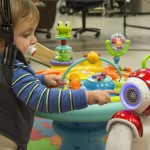 Last year I wrote about a new invention from MIT researchers that’s designed to ease the treatment of small children in hospital. The device, called Huggable, is a teddy bear robot that aims to provide support and comfort to children with chronic illnesses, all the while reporting on various vital signs to their doctors.
Last year I wrote about a new invention from MIT researchers that’s designed to ease the treatment of small children in hospital. The device, called Huggable, is a teddy bear robot that aims to provide support and comfort to children with chronic illnesses, all the while reporting on various vital signs to their doctors.
Suffice to say, a big part of the appeal of Huggable is that the device looks just like a teddy bear. A team from the University of Delaware are working on a similarly therapeutic robot, albeit one that doesn’t attempt to hide that it’s a robot.
The robot, that’s been called NAO, is capable of reading the mood of the child, recognizing their family and even understanding your preferences for food, music and so on.
Friendly robotics
“Our hope is that the robot will act as a magnet for very young children with disabilities, along with their typically developing peers, engaging them in dynamic group activities — controlled chaos full of fun, friends and fitness,” the team say.
“Pediatric rehabilitation equipment and training currently do not meet the needs of kids with motor disabilities,” they continue. “Young children’s overall knowledge depends on their ability to be mobile with peers — once they start moving, they begin to learn about the world in fundamentally different ways.”
The robot is designed to reflect some of the sophisticated robotic toys that are currently on the market. It’s designed to engage socially with the children but also to deliver personalized interventions based upon the individual traits of the child.
The plan is for NAO to develop learning mechanisms that will allow it to adapt to its environment without needing programming from the developers.
This ability will allow NAO to both lead the children through the prescribed training routine, whilst also knowing when enough is enough. For instance, it will be able to detect when the child’s attention wanders and can attempt to re-engage them.
“We all know that babies’ behavior is highly dynamic,” the team say. “NAO and our entire research team will have to be equally dynamic, which should result in both significant and innovative gains for pediatrics and robotics.”
Working with the system
NAO is designed to work in partnership with a portable harness system that helps to support the weight of children to allow them to move about a specially designed space. It also functions with a network of cameras, sensors and accelerometers to monitor the motion and activity levels of the children.
The team will continue developing the product so it is better able to detect activity by understanding the fine distinctions in the movements children make.
They also hope to use the data collected during NAO’s usage to further improve how it functions, and once it has proved its merits in a test environment, the plan is to roll it out to a number of community homes in the area.
We’ve already seen successful implementations of companion robots in elderly care homes, and it seems likely that there will be similar success at the younger end of the market too.
It will be an interesting trend to monitor.